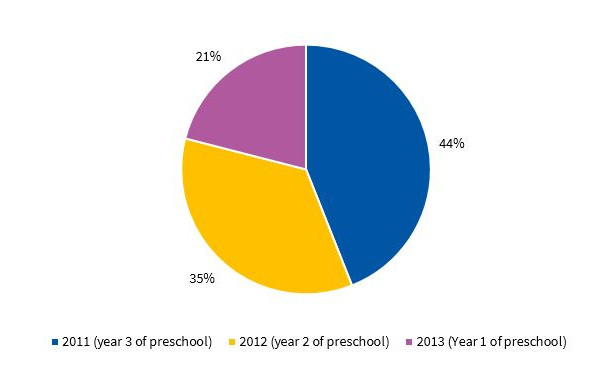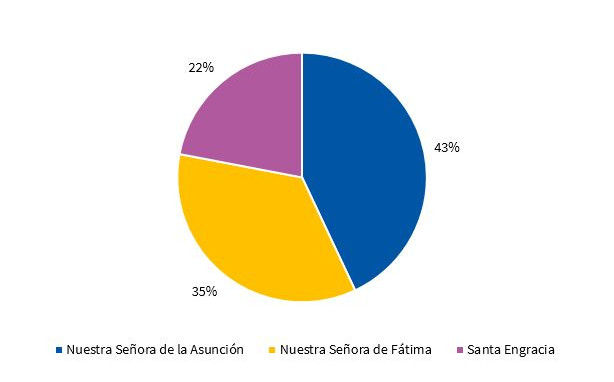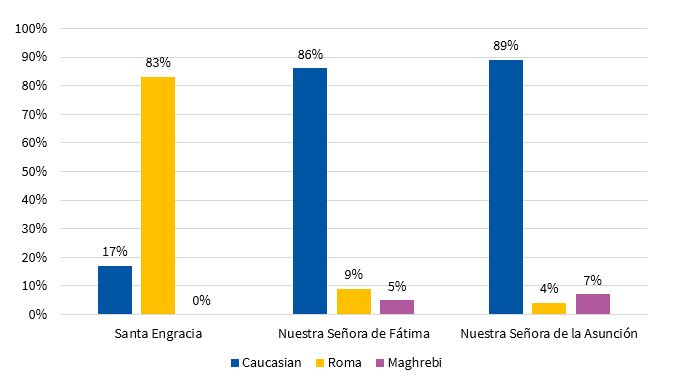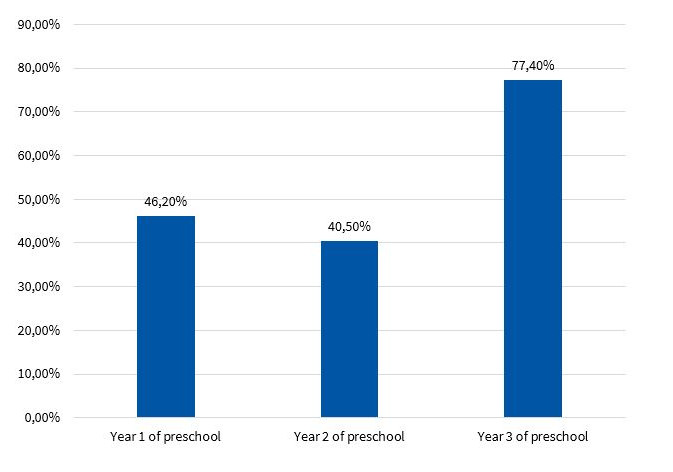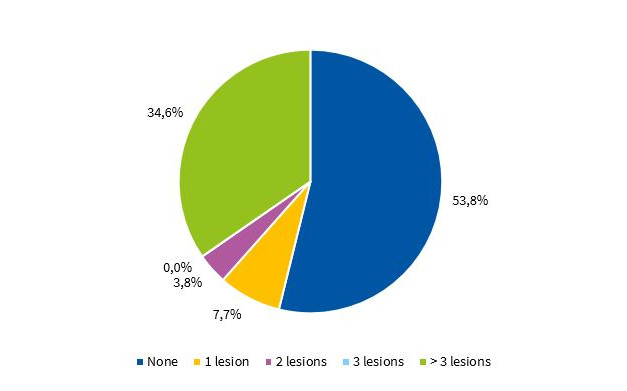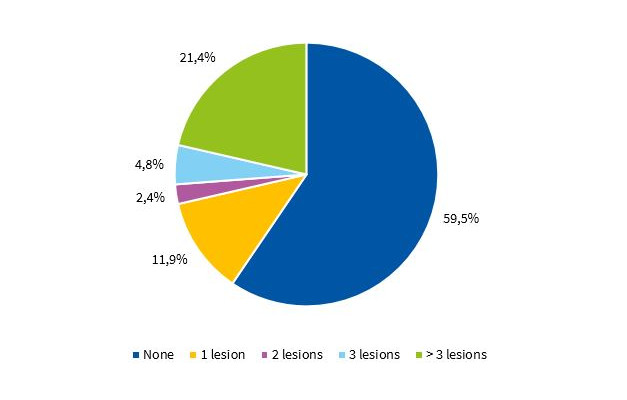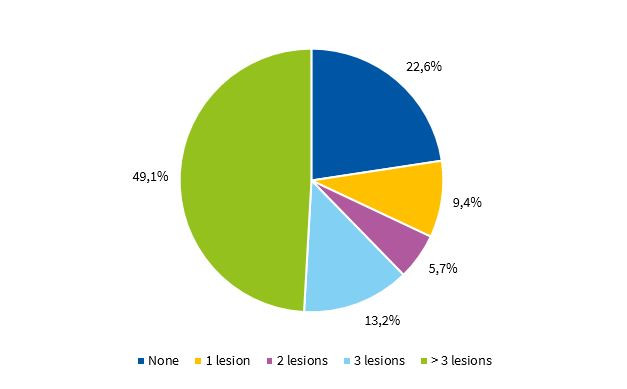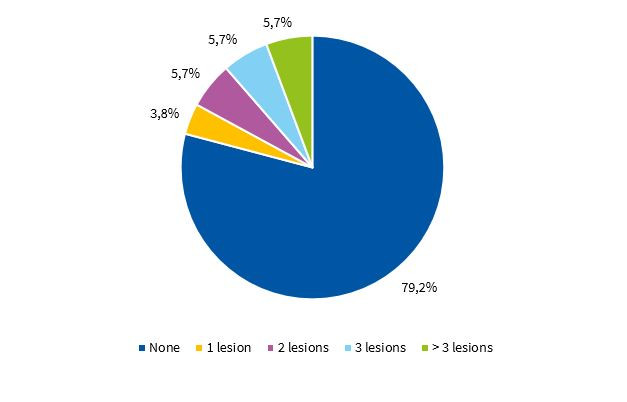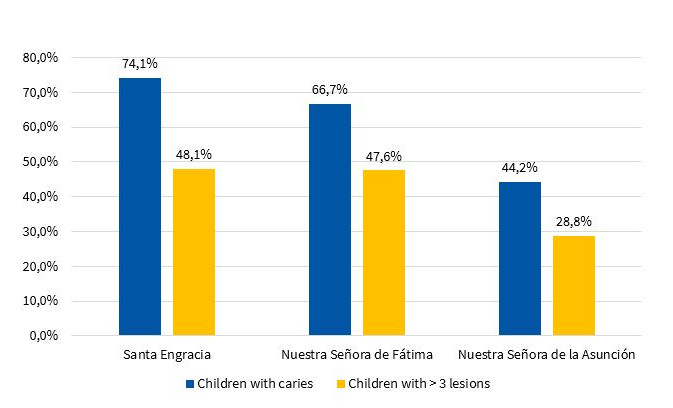Prevalence of dental caries in children enrolled in preschool education from a low socioeconomic status area
Ana Cubero Santosa, Isabel Lorido Canob, Almudena González Huéscarb, M.ª Ángeles Ferrer Garcíac, M.ª Dolores Zapata Carrascod, Juan Luis Ambel Sánchezc
aPediatra. CS El Progreso. Badajoz. España.
bEnfermera. CS El Progreso. Badajoz. España.
cUnidad de Salud Bucodental de las Zonas Básicas San Fernando, Gévora y El Progreso. Badajoz. España.
dDirección Programas Salud Bucodental. Servicio Extremeño de Salud. Badajoz. España.
Correspondence: A Cubero. E-mail: anacuberosantos@gmail.com
Reference of this article: Cubero Santos A, Lorido Cano I, González Huéscar A, Ferrer García MA, Zapata Carrasco MD, Ambel Sánchez JL. Prevalence of dental caries in children enrolled in preschool education from a low socioeconomic status area. Rev Pediatr Aten Primaria. 2019;21:e47-e59.
Published in Internet: 17-06-2019 - Visits: 78294
Abstract
Introduction: dental caries is a chronic disease with a high prevalence in Spanish young children. A poor oral hygiene, inadequate dietary habits and toothaches are frequent problems in our health district based on a previous situation analysis of health. Our objective was to perform a cross-sectional descriptive study to assess the prevalence of dental caries in children aged 3 to 5 years in our health district.
Materials and methods: a dentist performed an oral and dental evaluation while a dental hygienist collected data in children enrolled in years 1, 2 and 3 of preschool. The primary outcome was the presence of caries. The data were collected in individual forms and subsequently entered in a database created with the software SPSS, which we also used to perform the descriptive analysis of the data.
Results: of the 150 children enrolled in preschool in our health district, we assessed 121 that attended school on the day that we carried out the checkups (80.7%). We found caries in deciduous teeth in 46% of children enrolled in year 1, 40.5% of children in year 2 and 77.3% of children in year 3, and in permanent teeth in 20.8% of children in year 3.
Conclusions: the prevalence of caries was much higher in our health district compared to the previously reported nationwide prevalence. We need to increase the preventive interventions targeted to early childhood, especially in disadvantaged areas like our health district.
Keywords
● Deciduous teeth ● Dental caries ● Dental Hygiene ● Permanent teethINTRODUCTION
Dental caries is a disease with a high prevalence and constitutes one of the main public health problems worldwide.1-4 It is the most frequent form of dental disease and is considered the most frequent reason for seeking dental care in every age group.1,2 It is also the most frequent chronic disease in childhood, with a high prevalence in Spanish pre-schoolers. 5-7.
Caries is a multifactorial disease that stems from the interaction of 3 main factors: the host (oral hygiene, saliva and tooth characteristics), the microbiota and its substrate (diet), which together have an impact in the demineralization of dental hard tissues.2,6,7.
The most recent studies support the key role played by sugar in the development of dental caries. Sugars provide a favourable substrate for oral cariogenic bacteria to thrive and generate enamel-demineralising acids,8 leading to a dysbiosis with a predominance of colonies of sugar-dependent bacteria.9 The vast literature on dental caries shows that free sugars are a necessary dietary factor in the development of tooth decay. At present, there is a growing interest in research on the association of the most common risk factors, such as dietary sugar intake, and noncommunicable diseases such as diabetes, obesity or caries. Dental caries can be prevented by reducing the intake of sugars, appropriate use of fluoride and the promotion of adequate oral hygiene. Most of the factors involved in dental caries are modifiable, allowing individuals and health and dental care professionals to make the necessary choices to prevent this disease or reduce its severity.10
Historically, caries has been considered synonymous to cavities, which is incorrect, as cavities occur in the final stages of disease. White spot lesions are the first clinical sign of imbalance in the enamel surface. Caries is a dynamic process, as constant cycle of demineralization and remineralization is always unfolding at the tooth surface. If caries is diagnosed in the early stages, it is possible to stop or revert the process.1,6,7
Multiple studies have found an association between the prevalence of caries and socioeconomic status in both developing and developed countries. Children of lower socioeconomic levels tend to have caries more frequently and of greater severity.6,11-14
Caries is more frequent in parents with tooth decay and gum problems.6,15 Dental care in children, especially oral hygiene, are mainly dependent on the health knowledge of parents.16,17 This issue is important because it is known that children with caries in the primary teeth will probably become adults with multiple caries and restorations in the permanent dentition.2,6,18
According to a report published by the World Health Organization (WHO), 60% to 90% of school-aged children and nearly 100% of adults worldwide have dental caries.3 The effects of oral and dental disease in terms of pain, suffering, functional impairment and reduction in quality of life are considerable and costly. The WHO estimates that treatment for these diseases accounts for 5% to 10% of the health expenditure in developed countries, and that its costs exceed the available resources in many developing countries. The high costs of dental care could be avoided by implementing effective health prevention and promotion measures.2
As is the case of general health, there is a progressive social gradient for oral and dental diseases, which worsen with decreasing socioeconomic status. This social gradient is a universal phenomenon that affects the entire lifespan, from childhood through old age, and nearly all oral and dental diseases to varying degrees, including dental caries, periodontal disease and oral cancer. In 2008, the WHO called attention to the underlying causes of inequities highlighting so-called “social determinants”, that is, the circumstances under which people are born, grow, live, work and age.10
An oral health survey carried out in Spain in 2015 found that in the population of children aged 5 or 6 years, caries was most prevalent in those of lower socioeconomic level (38.3% versus 15.6% in children of higher socioeconomic levels) and children born outside Spain (with a ratio of 2 to 1.3), and also found a substantial difference in the access to treatment.19
An observational study conducted in a sample of 130 schoolchildren aged 3 to 12 years found a prevalence of childhood caries of 33%. There was a statistically significant association (p < 0.05) between caries and nationality (p = 0.004) and between caries and parental educational attainment (p = 0.005). The study also found statistically significant associations of caries with the presence of plaque (p = 0.002), the duration of tooth brushing (p = 0.005), the use of pacifiers dipped in sugar or sweet solutions (p = 0.015) and bruxism (p = 0.025). As concerns dietary habits, there was a statistically significant association between the consumption of gum (p = 0.006), sweet baked goods (p = 0.009), dairy products (p = 0.093) and medicines and the development of caries (p = 0.005).20
The health district of El Progreso is an urban area located on the right bank of the Guadiana river as it crosses Badajoz very close to Portugal. It is bound to the south by railway tracks, which establish a geographical and to a certain degree cultural border separating it from the rest of the city of Badajoz. Its population has a constrictive age distribution, although it is still relatively young, with a majority of inhabitants aged from 20 to 55 years and higher fertility and birth rates compared to other neighbouring populations. Approximately 50% of the population in the district has no education or is illiterate. The socioeconomic level is very low, with a very high unemployment rate, and the employed subset mostly have temporary jobs or precarious work on account of their low skill level.21,22 We also ought to mention that this health district includes slum areas characterised by marginalization and social exclusion.
Two situations analysis (SAs) of public health have been conducted in this health district, whose findings were published in 2007 and 2014.21,22 The most recent one revealed that toothaches were the second most frequent reason for seeking emergency care in adults, and that the prevalence of this problem has increased relative to the previous analysis. The analysis stratified by age group showed that in the paediatric population, lack of hygiene and of proper nutrition, both factors intimately related to caries, were among the most common health problems.21,22
These results, added to our subjective impression that a significant percentage of the children managed in our primary care clinic had caries, led us to design this study to make a quantitative assessment of the problem. The objective was to determine the prevalence of caries in children aged 3 to 5 years in the health district of El Progreso.
MATERIALS AND METHODS
Study design
We conducted a cross-sectional descriptive study between April and October 2017.
Study universe
The population under study was the cohort of individuals residing in the El Progreso health district born in 2011, 2012 or 2013, who at the time of data collection were aged 3 to 5 years and were enrolled in the corresponding years of early childhood education.
Study sample
To facilitate data collection, we requested the collaboration of the 3 schools located within the health district. Thus, we collected data from children enrolled in the second cycle of early childhood education (years 1, 2 and 3 of preschool) in the schools Nuestra Señora de Fátima (NSF), Santa Engracia (SE) and Nuestra Señora de la Asunción (NSA). The first 2 are public schools and the third one is a publicly-funded, privately-run school.
We excluded children in the catchment population of the paediatrics department of the El Progreso primary care centre enrolled in schools outside of the boundaries of the health district who were therefore not attending the schools that participated in the study.
Variables
The variables under study were:
- School where the children in the sample were enrolled.
- Academic year.
- Presence of caries in deciduous teeth.
- Presence of caries in permanent teeth.
- Number of caries in deciduous teeth.
- Number of caries in permanent teeth.
Caries was diagnosed according to the WHO caries assessment system (4th edition),23 which defines caries as a lesion in the pit and fissure or on a smooth tooth surface with an unmistakable cavity, undermined enamel, or a detectably softened floor or wall. This was the definition applied in the survey of oral and dental health.
Children in years 1 and 2 of preschool (aged 3 and 4 years) do not have any permanent teeth, so we only assessed for the presence of caries in deciduous teeth in this age group. It is possible for children enrolled in year 3 of preschool to have some permanent teeth, so in this group we did differentiate between caries in deciduous teeth and caries in permanent teeth.
Study protocol
The research team consisted of the paediatrics basic care team (BCT) of the El Progreso primary care centre (paediatrician and nurse), a community-based health nursing intern in the same primary care centre, the oral and dental health team (ODHT) of the San Fernando primary care centre (dentist, dental hygienist and a dental assistant), and the dentist that is the coordinator of the dental plan office of the central services of the Health Department of Extremadura (HDE), located in the city of Merida (province of Badajoz, Spain).
The sources of data used in our study were the full list of minors enrolled in the schools located in the health district, which we obtained from the administration of the schools themselves, and a list of the children included in the catchment population of the paediatrics BCT of the El Progreso primary care centre, which we obtained from the integrated health system database of the HDE (known as JARA). We compared both lists to obtain a single list in which we classified children by school and academic year and whether the children were in the catchment population of paediatrics BHT of the El Progreso primary care centre.
Once we had determined the total number of children we had to assess, and, having requested the written informed consent of their legal guardians, we agreed with the schools on the dates that we would perform the oral and dental evaluation on the study participants. This checkup was performed by a team consisting of the dentist that coordinated the Dental Plan Office and the dental hygienist of the BHT. They assessed for symptoms of poor hygiene, caries or malocclusion through a visual assessment under adequate natural light and with non-invasive equipment. The data from these observations were recorded in individual forms, including identifying data for the student (name, school, academic year, and whether or not the child belonged to the catchment population of the paediatrics clinic in the health district), and any of the aforementioned oral or dental abnormalities, if identified. The data collection took place between May and June 2017.
Statistical analysis
We entered the data collected in the individual forms into a database developed with the software SPSS Statistics (version 22.0), which we also used for the descriptive analysis of the data.
RESULTS
Of a total of the 150 eligible children enrolled in participating schools, 120 attended school on the day that we conducted the first checkup at the school, and 1 other had a checkup later on at the oral and dental health clinic. Thus, we obtained a final sample of 121 children, amounting to 80.7% of the total population under study.
In this sample, 21.5% of children were enrolled in year 1 of preschool, 34.7% in year 2 and 43.8% in year 3 (Figure 1). As for the schools they were enrolled in, 34.7% attended NSF, 43% NSA and 22.3% SE (Figure 2).
Figure 3 shows the distribution of the children by ethnicity in each of the 3 schools. Figure 4 represents the proportion of children that had caries in deciduous teeth enrolled in each school year. The stratified analysis by school year showed that 46.2% of children in year 1 had caries, with 34.6% having more than 3 decayed teeth (Figure 5). In year 2, 40.5% had caries, and 21.4% had more than 3 decayed teeth (Figure 6).
In children enrolled in year 3 of preschool we were able to differentiate between deciduous and permanent teeth. Thus, we found caries in deciduous teeth in 77.3 % of these children, in more than 3 teeth in 49.1%. We also found caries in permanent teeth in 20.8 % of children, with more than 3 such lesions in 5.7% (Figures 7 and 8).
We also found differences in the prevalence of caries between schools. We found caries in 66.7% of the children enrolled in NSF, and more than 3 in 47.6%. As for the children attending NSA, 44.2% had caries and 28.8% more than 3 such lesions. In SE, 74.1% of the assessed children had caries, with more than 3 in 48.1% (Figure 9).
In the overall sample, 41.3% of assessed children did not have any dental caries either in deciduous or in permanent teeth.
DISCUSSION
The WHO recognises oral health-related quality of life as a key component of general health and wellbeing. A healthy mouth goes with a healthy body. On the other hand, poor oral health can have deleterious consequences on the physical and psychosocial wellbeing of the individual.2,3
The first molars are usually the first permanent teeth to erupt, which is why the WHO considers the lower first molars as indicators to determine the prevalence of dental caries.
Among the findings of our study, we ought to highlight a prevalence of caries in children that was much higher compared to the prevalence reported in the most recently published oral health survey, from 2015,19 as can be seen in Figure 10.
| Figure 10. Percentage of children with caries found in the Oral and Dental Health Survey in Spain in 2015 and our study at the El Progreso primary care centre in Badajoz |
|---|
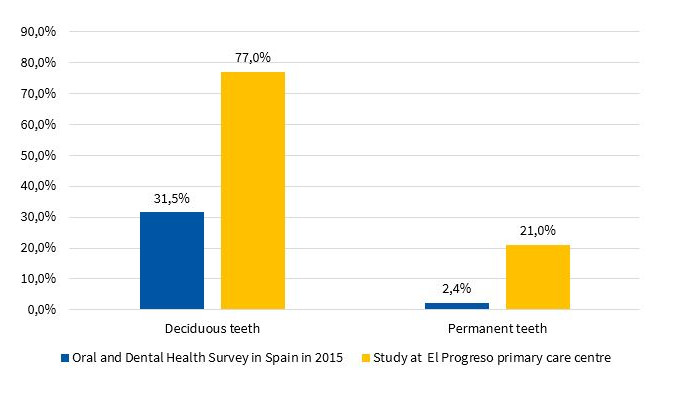 |

In the analysis of the prevalence of caries where we stratified by type of dentition—deciduous teeth (Figure 11) and permanent teeth (Figure 12) we also found frequencies that were substantially higher compared to the national average.
| Figure 11. Percent distribution by number of carious lesions in deciduous dentition in the Oral and Dental Health Survey in Spain in 2015 and our study at the El Progreso primary care centre in Badajoz |
|---|
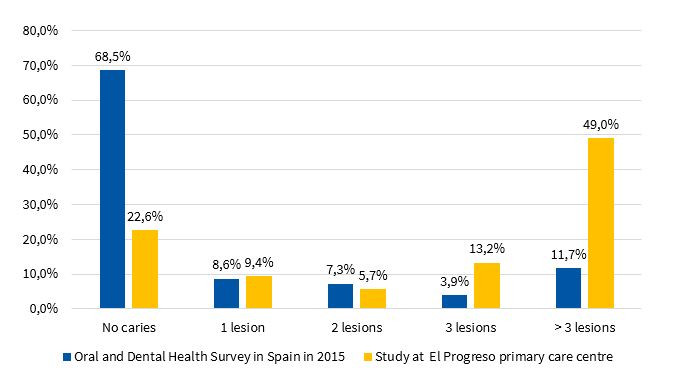 |

| Figure 12. Percent distribution by number of carious lesions in permanent dentition in the Oral and Dental Health Survey in Spain in 2015 and our study at the El Progreso primary care centre in Badajoz |
|---|
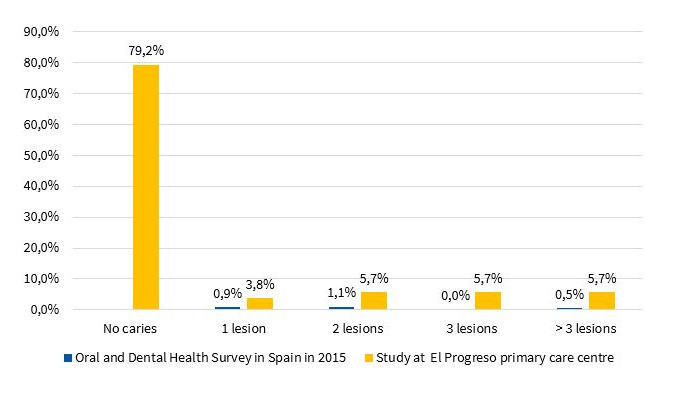 |

The prospective DELPHI study (2008-2020) established oral health goals for the deciduous dentition of the paediatric population for 202023:
- At least 90% of children aged 3 years free of caries (53.8% in our study in 2017).
- At least 83% of children aged 4 years free of caries (59.5% in our study in 2017).
- At least 75% of children aged 5 or 6 years free of caries (22.6% in our study in 2017).
Based on the findings of our study, we are far from achieving these goals.
Our results were consistent with those of most of the articles we reviewed, which found an association of caries with low socioeconomic level, income and educational attainment both in developed and developing countries.6,10-13 We verified that our population fulfilled the definition of low socioeconomic level by means of the aforementioned situation analysis of health,21 which showed that the population in our district was characterised by a low educational level and a high frequency of absenteeism and school failure. This results in a largely unskilled population with access to mainly precarious work, a high unemployment rate and frequent welfare dependency. One of the main problems in this population is that household incomes may not suffice to cover basic needs. We also ought to highlight that there is a subset of the catchment population of our health district at particular risk of social exclusion and marginalization, mainly of Roma ethnicity, and with a high prevalence of substance use; this group mainly resides in the neighbourhood where the Santa Engracia school is located, and this is the school where we found the most alarming prevalence of caries (74.1%).
We ought to mention a study conducted in rural communities in African countries that found an increased incidence of caries in children belonging to high-income upper classes because they could afford to consume sweets with high glucose and sucrose contents.24 This is not a new phenomenon, as it was already observed in the last century. In populations that suffered food scarcity due to World War II, the limited to non-existent consumption of sugars resulted in a drastic decrease in the incidence of caries. The report of the WHO also warned of the potential for this problem to arise again in the future, as it is likely that changes in living conditions in developing countries in Africa will lead to an increase in dental caries, mainly due to an increasing consumption of sugars and insufficient exposure to fluoride.2
There are profound inequalities in oral and dental health between world regions, countries and within countries. These inequalities may be related to socioeconomic differences, race and ethnicity, age, sex or general health status. While common dental diseases are preventable, not all members in the community are adequately informed or in a situation where they can benefit from adequate oral health promotion measures, as recognised in the Ottawa Charter.25 Reducing inequality requires wide-ranging, sweeping approaches targeting the populations at highest risk of specific oral and dental diseases as well as improving access to existing services.25
The protocols for the prevention of caries proposed by odontological societies recommend a first visit to the paediatric dentist around the time of the first birthday. The individual risk of caries should be evaluated at this point, and to do so paediatric dentists can avail themselves of any of the several tools available for the purpose. One of the most widely used tools is the Caries Management by Risk Assessment (CAMBRA), a questionnaire of which there is a version to assess risk in children aged up to 5 years and another to assess individuals aged 6 or more years.5
Working with families so that they establish the daily habits of oral hygiene from infancy is a key factor in the prevention of dental caries.5,8,26,27 It is our responsibility as health providers to make parents and caregivers aware of their important role. Many parents do not know that nutritious foods and drinks such as artificial formula and fruit juices have sugars that contribute to the development of caries, as does breastfeeding on demand and at night once teeth have started to erupt. We must inform parents that oral hygiene must start from the moment the first tooth erupts, brushing with an amount of toothpaste with fluoride (1000 ppm) the size of a grain of rice, at least twice a day and always before bedtime. This can be done with an age-appropriate toothbrush or with a silicone finger brush, cleaning the gums and the new teeth both in the upper and lower jaw, without rinsing. This “grain of rice” will grow to be as large as one lentil by age 3 years and a pea by age 5 years, at which point the fluoride dose should be increased to 1450 ppm.8 We must convey to parents and caregivers that the oral care of their children is their responsibility until the child develops the necessary motor skills to do it themselves, which usually does not happen until age 7 or 8 years. From this age and until adolescence, experts recommend that an adult continue to supervise at least the night-time toothbrushing.
Adequate oral hygiene from the first year of life helps both establish good habits and protect deciduous teeth. We are all born with the bacteria that cause caries, but not with the disease; we acquire good and bad habits, both dietary and of oral hygiene, from those who raise us, and our general and oral health will depend on these habits.8 As health providers, we need to explain that poor habits that ought to be avoided include sharing utensils with the baby (toothbrushes, spoons, toys etc), especially until age 2 years, cleaning pacifiers with saliva, cooling food by blowing directly on the spoon with the baby’s food or kissing the baby in the mouth or allowing pets to lick the baby’s mouth.
Good oral hygiene, the reduction of dietary sugars intake and a regular and adequate use of fluoride are key elements in caries prevention. Sugar substitutes such as sorbitol and xylitol and sweeteners like cyclamate or aspartame are not cariogenic.
In Spain, dental care programmes started to be established in the Basque Country and Navarra in 19904. In Extremadura, the childhood oral and dental care programme (PADIEX)28 was introduced much later, in 2005, and children remain in the programme from the year of their sixth birthday through the year they reach 15 years of age. It involves a minimum of 1 checkup per year, which includes an evaluation of dental health and the caries indices, an assessment of inadequate habits and education on hygiene measures, among other interventions. These visits may also include the application of topical fluoride, application of sealants in deep fissures or pits and removal of dental plaque (teeth cleaning). As has occurred in other autonomous regions (ARs) of Spain, this programme for childhood oral and dental care has proven effective in reducing the incidence of caries in children aged more than 6 years, but it is still insufficient, as it does not include care in younger children or deciduous teeth. With the aim of alleviating this problem, in 2018 the government of Extremadura, as had been done in other ARs, launched a new dental plan targeting children aged less than 6 years29 consisting exclusively in preventive interventions and the development of good habits; we cannot yet evaluate its impact, as the programme has been active for only a short time.
Caries is not a frequent reason for seeking care in primary care services, but when such cases occur it is because tooth decay has reached an advanced stage and is causing symptoms.
A positive aspect to consider in the design of strategies to address these problems, based on the findings of the SA, is that our population is aware that poor dietary and oral hygiene habits, both of which are intimately related to caries, are significant problems in our children. We believe that developing preventive activities focused on these aspects should be part of our efforts.
After we conducted the checkups in the schools, we sent the results to the parents along with a proposed date for an appointment at the primary care centre for the purpose of informing them, offering preventive care and scheduling follow-up visits at intervals that would vary depending on individual risk. We may consider performing another study to evaluate this followup.
Limitations of the study
One of the difficulties we encountered when we attempted to approach a population of these characteristics was the lack of scheduled dental checkups and treatment plans. For this reason, we decided to set up checkups in the schools after informing parents and obtaining their consent, as this would allow us to reach the greatest possible number of children. Still, since the study focused on early childhood, during which education is still not compulsory, and in an area where absenteeism is common, we were only able to include 121 of the 150 children enrolled in school. We expect that the prevalence of caries in the children we were unable to reach in this marginalised subpopulation is even worse.
CONCLUSION
Childhood dental caries is a problem that affects not only children and their families, but also society and the health care system. As paediatricians, we play an important role both in the early detection of tooth decay and in its prevention by providing adequate education to families. Children with caries in the temporary dentition are likely to become adults with caries in the permanent dentition if the initial caries are not treated during the white spot stage or when they are incipient and can still be controlled;2,5,8,18 if this is not achieved, the patient will need restorative treatments or even lose teeth prematurely.
We want to raise awareness on the alarming prevalence of caries in children aged 3 to 6 years in our health district, which were considerably higher than the prevalence reported in the nationwide oral health survey of 2015 and fell substantially short of the objectives set in the Delphi study.
We must concentrate our efforts in the prevention of caries from an early age as opposed to its treatment, insisting on establishing a routine first checkup to be performed at the time of the first birthday by primary care teams in public health centres.8,28 These efforts must be redoubled in low-income and marginalised areas7 with limited or no dental care resources, as is the case of our health district.
CONFLICTS OF INTEREST
The authors have no conflicts of interest to declare in relation to the preparation and publication of this article.
ABBREVIATIONS
AR: autonomous region · BCT: basic care team · HDE: Health Department of Extremadura · NSA: Nuestra Señora de la Asunción · NSF: Nuestra Señora de Fátima · ODHT: oro-dental health team · SA: situation analysis · SE: Santa Engracia · WHO: World Health Organization.
REFERENCES
- Cerón Bastidas XA. El sistema ICDAS como método complementario para el diagnóstico de caries dental. CES Odont. 2015;28:100-9.
- Informe sobre el problema mundial de las enfermedades bucodentales. In: World Health Organization [online] [accessed 10/06/2019]. Available at www.who.int/mediacentre/news/re leases/2004/pr15/es/
- Oral health. Factsheet no 318. April 2012. In: World Health Organization [online] [accessed 10/06/2019]. Available at www.who.int/mediacentre/factsheets/fs318/es
- Crovetto Martínez R, Ortuzar Otxoa L, Martínez Rodríguez A, Fernández Alonso J, Escobar-Martínez A. Valoración del riesgo de caries infantil en un servicio hospitalario de urgencias. Enferm Glob. 2016;15:1-9.
- Casals Peidró E, García Pereiro MA. Guía de práctica clínica para la prevención y tratamiento no invasivo de la caries dental. RCOE. 2014;19:189-248.
- Hernández Juyol M. Diagnóstico, pronóstico y prevención de la caries de la primera infancia. In: Protocolo de la Sociedad Española de Odontopediatría [online] [accessed 10/06/2019]. Available at www.odontologiapediatrica.com/wp-content/uploads/2018/06/SEOP_-_Caries_precoz_de_la_infancia_fin4.pdf
- González Sanz AM, González Nieto BA, González Nieto E. Salud dental: relación entre la caries dental y el consumo de alimentos. Nutr Hosp. 2013;28:64-71.
- Sheimham A. James WPT. Diet and dental caries: the pivotal role of free sugars reemphasized. J Dent Research. 2015;94:1341-7.
- Simón-Soro A, Mira A. Solving the etiology of dental caries. Trends Microbiol. 2015;23:76-82.
- Fukai K, Ogawa H, Hescot P. Oral health for healthy longevity in an ageing society: maintaining momentum and moving forward. Int Dental J. 2017;67:3-6.
- Mora León L, Martínez Olmos J. Prevalencia de caries y factores asociados en niños de 2-5 años de los Centros de Salud Almanjáyar y Cartuja de Granada capital. Aten Primaria 2000;26:398-404.
- Watanabe MK, Hostetler JT, Patel YM, Vergel de Dios JM, Bernardo MA, Foley ME. The impact of risk-based care on early childhood and youth populations. J Calif Dent Assoc. 2016;44:367-77.
- Medina Solis CE, Maupomé G, Pelcastre Villafuerte B, Ávila Burgos L, Vallejos Sánchez AA, Casanova Rosado AJ. Desigualdades socioeconómicas en salud bucal. Rev Invest Clin. 2006;58:296-304.
- Apaza Ramos S, Torres Ramos G, Blanco Victorio D, Antezana Vargas V, Montoya Funegra J. Influencia de los factores sociodemográficos, familiares y el estado de la salud bucal en la calidad de vida de adolescentes peruanos. Rev Estomatol Herediana. 2015;25:87-99.
- Herschfeld JJ. W. D. Miller and the “chemico-parasitic” theory of dental caries. Bull Hist Dent. 1978;26:11-20.
- Marrs JA, Trumbley S, Malik G. Early childhood caries: determining the risk factors and assessing the prevention strategies for nursing intervention. Pediatr Nurs. 2011;37:9-16.
- González Sanz A, González Nieto B, González Nieto E. Nutrición, dieta y salud oral. In: Castaño A, Ribas B. Odontología preventiva y comunitaria. La odontología social, un deber, una necesidad, un reto. Seville: Fundación Odontología Social; 2012. p. 155-69.
- Espasa E, Boj JR, Hernández M. Caries dental en el niño. In: Boj JR, Catalá M, García-Ballesta C, Mendoza A, Planells P. Odontopediatría. La evolución del niño al adulto joven. Madrid: Ripano; 2011. p. 213-23.
- Bravo Pérez M, Almerich Silla JM, Ausina Márquez V, Avilés Gutiérrez P, Blanco González JM, Canorea Díaz E, et al. Encuesta de Salud Oral en España 2015. RCOE. 2016;21:8-48.
- Alcaina Lorente A, Cortés Lillo O, Galera Sánchez MD, Guzmán Pina S, Canteras Jordana M. Caries dental: influencia de los hábitos de higiene bucodental y de alimentación en niños en edad escolar. Acta Pediatr Esp. 2016;74:246-52.
- Equipo de Atención Primaria. Análisis de la Situación de Salud de la Zona de Salud El Progreso. Centro de Salud El Progreso. Badajoz: Edita SES; 2014.
- Maynar Mariño I, Nieto Ramírez R, Montero de Espinosa Pérez P, Madueño García MA, Fernández López MD, Maynar Mariño MA. Proyecto Progreso: un sistema sanitario participado para el desarrollo integral del modelo de Atención Primaria de Salud. Comunidad. 2010;12:12-7.
- Llodra Calvo JC, Denis Bourgeois D. Estudio prospectivo Delphi. La salud bucodental en España 2020. Tendencias y objetivos de salud oral. In: Fundación Dental Española [online] [accessed 10/06/2019]. Available at www.consejodentistas.es
- Enwonwu C. Review of oral disease in Africa and the influence of socio-economic factors. Oral Dent Africa. 1981;31:1-5.
- The Ottawa Charter for Health Promotion. First International Conference on Health Promotion, Ottawa. Geneva: World Health Organization; 1986.
- Wagner Y, Greiner S, Heinrich-Weltzien R. Evaluation of an oral health promotion program at the time of birth on dental caries in 5-year-old children in Vorarlberg, Austria. Community Den Oral Epidemiol. 2014;42:160-9.
- Plutzer K, Spencer AJ. Efficacy of an oral health promotion intervention in the prevention of early childhood caries. Community Dent Oral Epidemiol. 2008;36:335-46.
- Decreto 195/2004, de 29 de diciembre, sobre asistencia dental a la población infantil de la Comunidad Autónoma de Extremadura. In: Diario oficial de Extremadura (DOE) [online] [accessed 10/06/2019]. Available at http://doe.juntaex.es/pdfs/doe/2005/20o/04040210.pdf
- Periódico del Servicio Extremeño de Salud [online] [accessed 10/06/2019]. Available at https://digitalextremadura.com/marcha-plan-atencion-dental-ninos-menores-6-anos/






